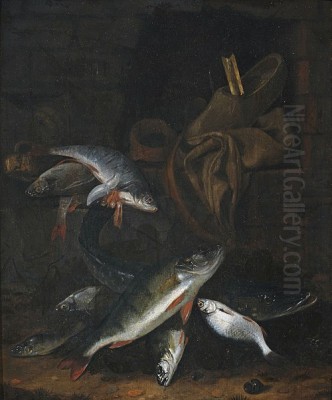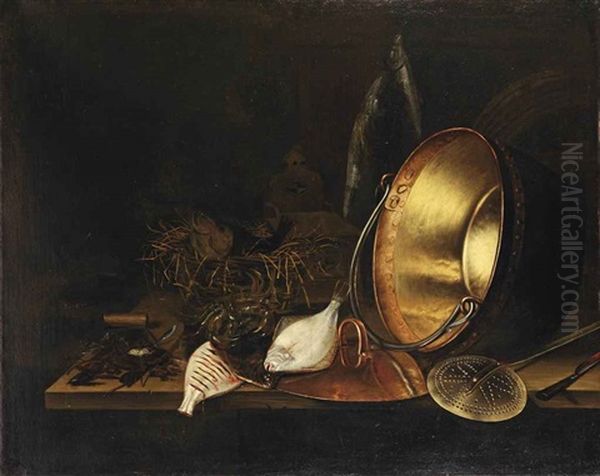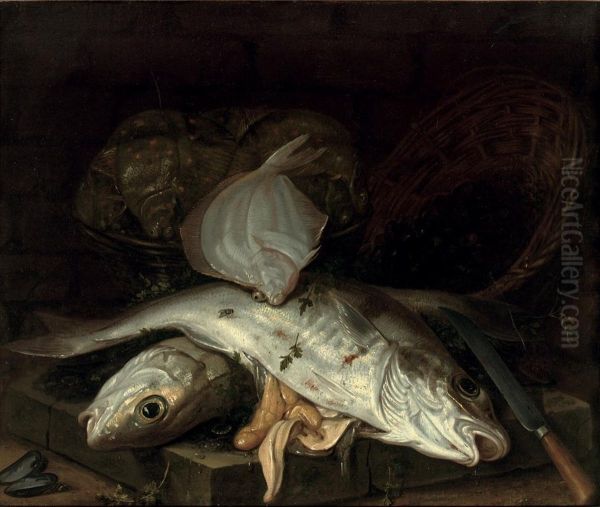
The 17th century in the Netherlands, often referred to as the Dutch Golden Age, was a period of extraordinary artistic efflorescence. Amidst a burgeoning economy and a society increasingly appreciative of art, painters explored a wide array of subjects, catering to the tastes of a diverse clientele. Among the specialized genres that flourished, still life painting held a prominent place, and within this category, a particular niche was carved out by artists who dedicated themselves to the depiction of fish. Jakob Gillig (circa 1636-1701) stands as a notable figure in this specific domain, an artist whose life and work offer a fascinating glimpse into the art world of Utrecht and the unique appeal of aquatic subjects.
The Artistic Climate of the Dutch Golden Age
To understand Jakob Gillig's contribution, it is essential to appreciate the broader context of the Dutch Golden Age. This era witnessed an unprecedented boom in painting, driven by a prosperous merchant class eager to adorn their homes with artworks. Unlike in many other parts of Europe where art was primarily commissioned by the Church or aristocracy, in the Dutch Republic, a wider segment of society, including affluent burghers, artisans, and shopkeepers, became art patrons. This democratization of art ownership led to a diversification of subject matter. Portraits, landscapes, seascapes, genre scenes depicting everyday life, and, of course, still lifes in myriad forms became immensely popular. Artists often specialized, honing their skills in particular areas to meet market demands and establish their reputations.
The still life genre itself was incredibly varied, encompassing lavish banquet pieces (pronkstilleven), modest breakfast scenes (ontbijtjes), intricate flower paintings, and symbolic vanitas compositions. The meticulous realism and illusionistic detail achieved by Dutch painters were highly prized, reflecting a culture that valued keen observation and technical skill. Artists like Willem Kalf, Abraham van Beyeren, and Pieter Claesz. became renowned for their opulent displays or their subtle arrangements of everyday objects, each imbuing their subjects with a palpable sense of presence.
Utrecht: A Hub of Artistic Activity

Jakob Gillig was born around 1636 in Utrecht, a city with a rich artistic heritage. While perhaps not as dominant as Amsterdam or Haarlem in certain genres, Utrecht had its own vibrant painters' guild, the Guild of Saint Luke, and a history of significant artistic movements, including the Utrecht Caravaggisti like Hendrick ter Brugghen and Gerrit van Honthorst earlier in the century. By Gillig's time, the city continued to support a community of artists working in various styles. Figures such as Abraham Bloemaert had a long and influential career there, and later, painters like Abraham Mignon, known for his lush flower and fruit still lifes, were active contemporaries of Gillig in Utrecht.
Interestingly, despite being born and dying in Utrecht, Jakob Gillig was never formally registered as a member of the Utrecht Guild of Saint Luke. This was unusual for a practicing painter, as guild membership typically provided a license to sell work, take on apprentices, and participate in the official art market of the city. Gillig's path was unconventional; he initially pursued a career in commerce and later served as a prison warden. This background sets him apart from many of his contemporaries who typically underwent formal apprenticeships from a young age.
An Unconventional Path: From Commerce to Canvas
Jakob Gillig's decision to take up painting reportedly occurred when he was around twenty years old, roughly in the mid-1650s. This relatively late start, combined with his other professional responsibilities, makes his artistic output and the quality he achieved all the more remarkable. His role as a prison warden is particularly intriguing. The prison in Utrecht was located near the fish market, and it is widely believed that this daily proximity to the bustling market, with its sights, sounds, and, undoubtedly, smells of fresh and saltwater fish, profoundly influenced his choice of subject matter.
This direct, everyday exposure to his primary subjects likely provided Gillig with an intimate knowledge of their forms, textures, and colors. Unlike artists who might rely on sketches or memory, Gillig had a constant, living reference point. This immersion is reflected in the naturalism and convincing detail that characterize his fish still lifes. While he is also known to have painted some portraits, these are far less common and his reputation rests firmly on his depictions of aquatic life.
The Specialization in Fish Still Lifes
Gillig's focus on fish was not entirely unique in the Dutch Golden Age, but he became one of its most dedicated practitioners. Other artists, such as Abraham van Beyeren (who also painted lavish banquet scenes), Pieter de Putter, and Isaac van Duynen, also excelled in fish still lifes. Alexander Adriaenssen, a Flemish painter, was another notable artist in this subgenre whose work was known in the Netherlands. However, Gillig’s commitment to this theme was central to his artistic identity.

His compositions typically feature a variety of freshwater and saltwater fish, often arranged in a seemingly casual yet artfully constructed manner. They might be piled in a basket, laid out on a stone ledge, or grouped near fishing nets and tackle. The settings are usually simple, allowing the focus to remain squarely on the fish themselves. The choice of fish – herring, cod, haddock, perch, pike, and others – reflected the bounty of the North Sea and inland waters, and these were staple foods in the Dutch diet.
The appeal of fish still lifes was multifaceted. On one level, they were a celebration of nature's abundance and the nation's maritime prowess. On another, they showcased the painter's skill in rendering the challenging textures of scales, the moist sheen of freshly caught fish, and the subtle gradations of color. There might also have been symbolic undertones; fish were ancient Christian symbols (ichthys), and in a broader sense, like all still lifes, they could serve as reminders of the transience of life (memento mori), given the perishable nature of the subject.
Artistic Style and Technique
Jakob Gillig worked primarily in oils, the dominant medium of the era, which allowed for rich colors, smooth blending, and the buildup of translucent glazes to achieve depth and luminosity. His style is characterized by a robust realism and a keen eye for detail. He was particularly adept at capturing the silvery, iridescent quality of fish scales, the wetness of their skin, and the varied textures of different species.
His compositions are often straightforward but effective. He frequently employed a relatively close-up perspective, bringing the viewer into direct engagement with the subjects. The lighting in his paintings tends to be clear and directional, modeling the forms of the fish and highlighting their textures. While his palette could be somewhat subdued, focusing on the naturalistic grays, silvers, browns, and subtle pinks of the fish, he used these colors with great skill to create a sense of volume and life.
Compared to the more flamboyant pronkstilleven of artists like Willem Kalf or Jan Davidsz. de Heem, Gillig's fish still lifes often possess a more humble, unpretentious quality. This is not to say they lack artistry; rather, their beauty lies in their directness and the painter's evident fascination with his subject. He managed to convey the physicality of the fish – their weight, their coolness, their slightly slippery surfaces – with remarkable fidelity.
Representative Works
Identifying specific, universally acclaimed "masterpieces" for Gillig can be challenging, as many works by still life painters of this era share common themes and titles. However, his oeuvre is consistently recognized for its quality within his chosen specialization.

One work often cited or representative of his output is generally described as "Still life with fish," sometimes specifying types like haddock or cod. For instance, a piece titled "Still life with freshwater fish" or "Flussfische im Fishmarkt" (Freshwater Fish at a Fish Market) exemplifies his typical subject and approach. Such paintings would showcase an assortment of river fish, perhaps pike, perch, and carp, meticulously rendered and arranged on a simple surface, sometimes with a fishing basket or net.
A painting titled "Still life with haddock" would feature these saltwater fish, again demonstrating his skill in capturing their distinct characteristics. The reference to "1600-1800" in the provided source likely frames the general period of such fish still lifes rather than a specific creation date for a particular work by Gillig, whose active period was roughly 1656-1701.
His works, such as "Still Life of Fish in a Basket with a Cat," introduce a narrative element and a touch of domesticity, a common trope in Dutch still life where animals interact with the displayed food. These paintings demonstrate his ability to create dynamic compositions and textures, from the wicker of the basket to the fur of the cat and the scales of the fish.
Gillig and His Contemporaries
Jakob Gillig operated within a rich artistic ecosystem. While the provided information suggests no known direct collaborations with painters like Jan Davidsz. de Heem, Pieter Claesz., or Evert Collier, these artists were significant figures in the broader field of still life painting during the Dutch Golden Age, and their work would have formed part of the visual culture Gillig inhabited.
Jan Davidsz. de Heem (1606-1684): Active in both Utrecht and Antwerp, de Heem was a master of lavish still lifes, including fruit, flowers, and banquet pieces. His opulent style contrasts with Gillig's more focused fish studies, but he represents the pinnacle of decorative still life.
Pieter Claesz. (c. 1597-1660): Known for his "monochrome" breakfast pieces (ontbijtjes), Claesz. excelled at depicting humble arrangements of bread, herrings, and simple tableware with subtle tonal harmonies. His focus on everyday items and textures resonates with Gillig's approach, albeit with different subjects.
Willem Claeszoon Heda (1594-1680): A contemporary and peer of Pieter Claesz., Heda also specialized in monochrome still lifes, often featuring overturned silver goblets, pewter plates, and partially eaten pies, showcasing remarkable textural skill.
Evert Collier (c. 1642-1708): Active in Haarlem and Leiden, and later London, Collier was known for his vanitas still lifes and trompe-l'œil paintings, often featuring books, musical instruments, and globes, reminding viewers of the transience of worldly pursuits.

Abraham van Beyeren (c. 1620-1690): A highly versatile still life painter, van Beyeren was renowned for his sumptuous banquet scenes but also produced exceptional fish still lifes, making him a more direct contemporary in terms of subject matter. His fish pieces are often characterized by a rich, painterly technique.
Willem Kalf (1619-1693): Famous for his pronkstilleven featuring luxurious objects like Chinese porcelain, Turkish carpets, and elaborate glassware, Kalf represented the height of ostentatious still life.
Rachel Ruysch (1664-1750): A leading female artist of the period, Ruysch specialized in dynamic and meticulously detailed flower paintings, often with insects, achieving international fame.
Abraham Mignon (1640-1679): Born in Frankfurt but active primarily in Utrecht, Mignon was a contemporary of Gillig in the same city. He was a pupil of Jan Davidsz. de Heem and became famous for his highly detailed and richly colored flower and fruit still lifes.
Matthias Withoos (1627-1703): Also active in Utrecht for a period, Withoos (also known as Calzetta Bianca) specialized in a unique type of still life known as sottobosco (forest floor), featuring wild plants, insects, reptiles, and fungi in dark, atmospheric settings. Otto Marseus van Schrieck was another master of this subgenre.
Cornelis Saftleven (1607-1681): While known for genre scenes and animal paintings, Saftleven's work sometimes included detailed studies of animals that bordered on still life, reflecting the era's interest in the natural world.
Adriaen van Ostade (1610-1685): A master of peasant genre scenes, his depictions of interiors often included carefully rendered still life elements, contributing to the overall realism of his work.
These artists, among many others like Rembrandt van Rijn, Johannes Vermeer, and Frans Hals who dominated other genres, collectively shaped the artistic landscape of the Dutch Golden Age. Gillig's specialization found its place within this diverse and competitive environment.
The Significance of Not Joining the Guild
Gillig's decision, or perhaps circumstance, of not being a registered master in the Utrecht Guild of Saint Luke is noteworthy. Guilds played a crucial role in regulating trade, maintaining quality standards, and providing a social and professional network for artists. Membership usually required a period of apprenticeship under a recognized master and the payment of fees.

It's possible that Gillig, with his established career as a merchant and prison warden, viewed painting more as a passionate avocation than his primary source of income, thus feeling less need for guild affiliation. Alternatively, he might have sold his works through dealers or directly to patrons, bypassing some of the formal guild structures. His unique position, however, did not seem to hinder his ability to produce a respected body of work. This independence, while unusual, underscores a certain flexibility that might have existed within the art world, or perhaps highlights Gillig's personal resourcefulness.
The Market and Appeal of Fish Still Lifes
The market for fish still lifes like those by Jakob Gillig was robust enough to support specialists in the field. These paintings would have appealed to a range of buyers. For those involved in the fishing industry or maritime trade, they could be a direct reflection of their livelihood. For others, they represented the bounty of the Dutch waters and the everyday sustenance of the nation. The Dutch prided themselves on their connection to the sea, and herring, in particular, was a cornerstone of their economy and diet.
Beyond their literal subject matter, these paintings were appreciated for their artistic merit. The challenge of realistically depicting the slick, scaly surfaces of fish, their varied forms, and the interplay of light upon them was a test of a painter's skill. A well-executed fish still life was a testament to the artist's mastery of observation and technique. In homes, such paintings could add a touch of rustic charm or a reminder of nature's provision, fitting well within the Dutch preference for art that reflected their world and values.
Legacy and Distribution of Works
Jakob Gillig passed away in Utrecht on July 24, 1701, leaving behind a respectable collection of works that continue to be admired for their specific focus and skilled execution. Today, his paintings are found in various public and private collections.

The provided information indicates that his works appear at auctions, such as a piece titled "MARTWA NATURE Z RYBAMI" (Still Life with Fish), and are held in private collections, exemplified by "Halcsendélet" (Still Life) noted in the Festetics Andor collection. While specific museum holdings are not extensively detailed in the initial information, it's common for works by recognized Dutch Golden Age painters like Gillig to be represented in museums with significant collections of Dutch art, particularly in the Netherlands and Germany (the mention of "Flussfische im Fishmarkt" being in a Berlin museum aligns with this). Galleries, both historically and in the contemporary art market, would also handle and exhibit such works. The mention of "Hugo Galerie, Galerie Ariel Paris, and Galerie Bertrand Gillig" suggests ongoing market interest, though "Galerie Bertrand Gillig" might be a modern gallery with a coincidental name or one specializing in older masters.
Gillig's legacy lies in his dedicated contribution to the niche genre of fish still life. He may not have the sweeping fame of a Rembrandt or Vermeer, but within his chosen field, he is a recognized and respected master. His paintings offer a window into the everyday life, diet, and artistic tastes of the Dutch Golden Age, capturing the humble yet essential bounty of the waters with honesty and skill.
Conclusion: An Enduring Slice of Dutch Life
Jakob Gillig's art provides more than just aesthetically pleasing images of fish; it encapsulates a specific aspect of 17th-century Dutch culture. His unconventional career path, from merchant and prison warden to a dedicated painter of aquatic life, adds a layer of intrigue to his story. His close proximity to the Utrecht fish market gave him an unparalleled intimacy with his subjects, which translated into works of remarkable naturalism and textural fidelity.
In an era teeming with artistic giants and diverse specializations, Gillig carved out a distinctive niche. His fish still lifes, while perhaps less grand than the opulent compositions of some contemporaries, possess a quiet dignity and an undeniable mastery of their specific subject. They remind us of the importance of the sea and inland waters to Dutch life and celebrate the everyday sustenance that formed the backbone of the nation. Jakob Gillig remains a significant figure for those who appreciate the depth and diversity of Dutch Golden Age still life painting, a testament to an artist who found profound beauty in the familiar forms of the aquatic world. His work endures as a skilled and heartfelt depiction of a vital, if often overlooked, aspect of Dutch heritage.